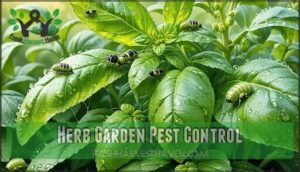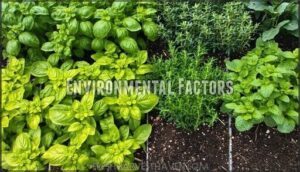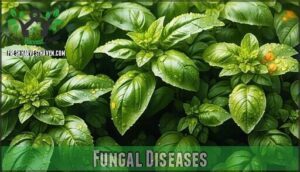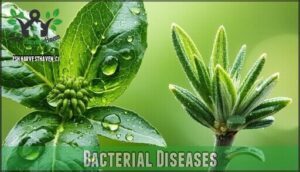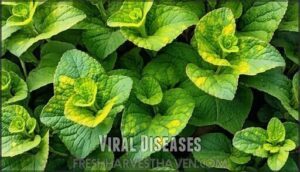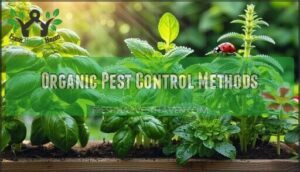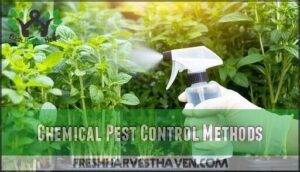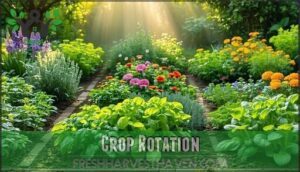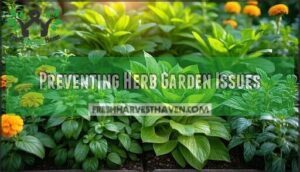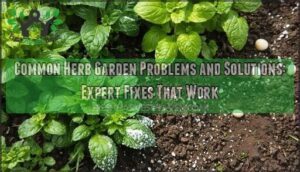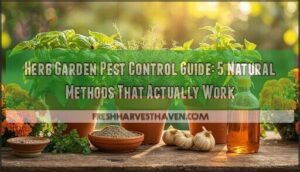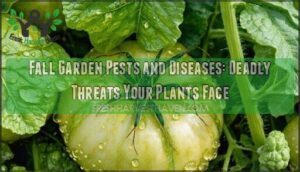This site is supported by our readers. We may earn a commission, at no cost to you, if you purchase through links.
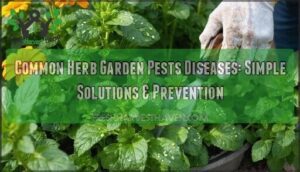
Fungal diseases like powdery mildew and downy mildew thrive in humid conditions, while bacterial infections spread through water and poor air circulation.
You’ll spot yellowing leaves, sticky honeydew, webbing, or chewed foliage as early warning signs.
Prevention beats cure – maintain proper spacing, water at soil level, and inspect plants weekly.
Simple solutions like neem oil, companion planting with marigolds, and removing affected leaves work wonders.
Smart gardeners know the real secret lies in understanding what triggers these problems and that prevention is key to a healthy garden.
Table Of Contents
- Key Takeaways
- Herb Garden Pest Control
- Environmental Factors
- Common Herb Diseases
- Pest Management Strategies
- Preventing Herb Garden Issues
- Frequently Asked Questions (FAQs)
- What is killing my herb garden?
- What bugs are eating my herbs?
- What are some of the diseases spread by garden pests?
- What is the most common pest in the garden?
- What bug is eating my herbs?
- What is wrong with my herbs?
- What are signs of nutrient deficiency in herbs?
- How often should herb gardens be fertilized?
- Can herbs be grown indoors year-round successfully?
- What role does mulching play in herb gardens?
- Conclusion
Key Takeaways
- Monitor your herbs weekly – You’ll catch problems early when they’re easier to fix, spotting telltale signs like yellowing leaves, webbing, or chewed foliage before pests spread throughout your garden.
- Focus on prevention over treatment – You’ll save time and money by maintaining proper plant spacing, watering at soil level, and ensuring good air circulation rather than fighting established infestations.
- Use organic solutions first – You can effectively control most pests with neem oil, companion planting with marigolds, and encouraging beneficial insects without resorting to harsh chemicals.
- Create healthy growing conditions – You’ll naturally resist pests and diseases by maintaining well-draining soil, proper humidity levels, and removing garden debris that harbors harmful organisms.
Herb Garden Pest Control
You’ll face various pests in your herb garden, but identifying them early makes control much easier.
Common culprits include aphids clustering on stems, spider mites creating webbing, caterpillars chewing holes in leaves, and slugs leaving slimy trails behind, which can be controlled if you identify them early.
Identifying Common Herb Pests
Early detection protects your herbs from devastating damage.
Aphid identification starts with spotting tiny, soft-bodied insects clustering on stems and leaves.
Mite webbing appears as fine threads with yellow speckles on foliage.
Look for caterpillar droppings near chewed leaves—these dark pellets signal hungry larvae.
Slug trails leave unmistakable slimy streaks across plants and soil.
Whitefly infestation occurs beneath leaves, where these small white insects weaken herbs rapidly.
Regular garden pest identification prevents common herb pests from destroying your harvest.
Check plants weekly for these telltale signs.
Aphids and Whiteflies
Aphids and whiteflies are common herb pests that can quickly overwhelm your garden.
These tiny insects cluster on leaves and stems, with aphids producing sticky honeydew that attracts ants and promotes mold growth.
Aphids turn your thriving herbs into sticky, ant-attracting disasters overnight.
Whiteflies weaken plants through sap extraction and disease transmission.
Watch for infestation signs like curled, yellowing leaves or clouds of white insects when plants are disturbed.
Combat them with organic pest control methods: wash aphids off with water, vacuum whiteflies, and encourage natural predators like ladybugs and lacewings.
Companion planting, such as using basil with tomatoes, can also help.
Spider Mites and Caterpillars
Throughout your herb garden, spider mites and caterpillars can devastate your precious herbs without warning. These tiny spider mites thrive in hot, dry conditions and create telltale mite webbing on leaf undersides. You’ll spot their damage as yellow stippling across leaves.
Caterpillars chew irregular holes and leave caterpillars droppings nearby, consuming up to 30% of foliage weekly. Combat these herb garden pests with organic pest control methods. Neem oil effectively targets spider mites, while Bt treatment specifically eliminates caterpillar larvae.
Consider swallowtail tolerance for parsley worms, as they become beautiful butterflies. For thorough spider mite solutions, consider specialized treatments.
Prevention strategies include:
- Maintain consistent soil moisture to deter spider mites
- Handpick caterpillars during evening inspections
- Introduce beneficial predators like ladybugs and predatory mites
- Monitor twice weekly during warm, dry periods
- Use sticky traps for early detection of adult moths
Regular monitoring prevents these common garden diseases from establishing in your herbs, ensuring the health of your herb garden through regular maintenance and effective pest control.
Slugs and Snails
While spider mites create visible webbing, slugs and snails leave different calling cards.
These slimy herb garden pests create ragged holes in leaves and silvery trails across your plants.
Beer traps and copper barriers effectively deter them, while natural predators like birds help control populations.
Organic pest control methods target snail habitats around moist areas.
| Problem | Solution |
|---|---|
| Slug damage on tender herbs | Apply diatomaceous earth around plants |
| Snails hiding in garden debris | Remove mulch and hiding spots regularly |
| Nighttime feeding activity | Set beer traps near affected areas |
| Recurring infestations | Encourage birds and frogs as natural predators |
Environmental Factors
Your herb garden’s environment directly influences pest and disease pressure. Temperature, humidity, soil conditions, and airflow create the foundation for either healthy plants or pest-friendly conditions.
Humidity and Temperature
Understanding temperature and humidity helps you prevent most herb garden problems.
High humidity creates perfect conditions for fungal infections like powdery mildew, while poor air circulation traps moisture around plants.
Optimal Ranges for most herbs include:
- Humidity levels: 40-60% prevents fungal growth
- Temperature impact: 65-75°F maintains healthy growth
- Air circulation: Gentle breeze reduces moisture buildup
- Microclimates: Avoid creating pockets of stagnant air
- Soil quality: Well-draining prevents root rot
Humidity effects vary by season, so adjust watering accordingly. Space plants properly to promote airflow and prevent disease-friendly conditions.
Soil Quality and Moisture
Quality soil sets the foundation for healthy herbs.
Strong soil creates the foundation for thriving herbs that naturally resist pests and diseases.
You’ll want to check these basics to prevent pest problems and plant stress.
- Soil pH: Test and maintain levels between 6-7 for ideal nutrient uptake
- Drainage Needs: Verify water flows freely to prevent waterlogged soils and root rot
- Organic Matter: Add compost regularly to improve soil health and structure
- Watering Practices: Water deeply but less frequently to encourage strong root systems
- Mulch Benefits: Apply organic mulch to retain moisture levels and suppress weeds
Good drainage prevents most soil-related issues while proper moisture levels keep plants thriving.
Sunlight and Air Circulation
After ensuring proper soil drainage and moisture levels, your herbs also need optimal sunlight and strong air circulation to thrive. Most herbs require six hours of direct sunlight daily, but protect them from scorching afternoon heat. Many herbs, like tomatoes, will struggle without adequate direct sunlight.
Preventing overcrowding is essential—space plants properly to enhance airflow benefits and reduce humidity around leaves. Good circulation methods include strategic plant placement and regular pruning techniques that open up dense growth.
| Light Needs | Spacing Distance | Air Flow Tips |
|---|---|---|
| 6+ hours direct sun | 12-18 inches apart | Prune regularly |
| Morning sun preferred | Avoid tight clusters | Remove lower leaves |
| Shade during peak heat | Avoid tight clusters | Thin dense areas |
| Rotate for even exposure | Check mature size | Use fans if needed |
Poor air circulation creates perfect conditions for fungal infections to develop and spread throughout your garden.
Common Herb Diseases
Your herb garden faces threats from diseases that can quickly spread and damage your plants.
Understanding these common diseases helps you spot problems early and take action before they destroy your harvest.
Fungal Diseases
Fungal diseases like powdery mildew and rust thrive in humid conditions with poor air circulation.
Disease identification starts with spotting white powdery coatings, yellow spots, or orange pustules on leaves.
Improve soil drainage and increase humidity control through proper plant spacing.
Preventative measures include morning watering and removing infected foliage.
Organic fungicides effectively manage fungal infections without harsh chemicals.
Bacterial Diseases
While fungal diseases attack your herbs from the outside, bacterial diseases work differently.
Bacterial leaf spots create water-soaked lesions that turn brown, while bacterial wilt causes sudden plant collapse.
Identifying bacteria early helps – look for sticky ooze and soft, mushy stems.
Disease prevention starts with avoiding overhead watering and improving air circulation.
Bacterial spread happens through contaminated tools, so sterilize equipment between plants.
Treatment options include copper-based sprays and removing infected material.
Organic disease control focuses on sanitation and proper spacing to prevent bacterial symptoms from destroying your herb disease treatment efforts.
Viral Diseases
When viral diseases strike your herb garden, you’ll notice distinctive warning signs that demand immediate attention.
These pathogens cause significant damage through various Transmission Vectors, making early Virus Identification essential for effective management.
Key viral diseases affecting herbs:
- Mosaic Virus – Creates mottled, discolored leaf patterns that reduce Plant Immunity
- Impatiens Necrotic Spot Virus – Causes brown spots and wilting in susceptible plants
- Tomato Spotted Wilt Virus – Produces ring-shaped lesions and stunted growth
Disease Symptoms include yellowing foliage, distorted leaves, and reduced vigor.
Unfortunately, Treatment Options remain limited since viral diseases can’t be cured once established.
To help, consider encouraging beneficial insects within your garden.
Pest Management Strategies
When pests invade your herb garden, you don’t have to reach for harsh chemicals right away.
Smart management combines organic methods, targeted treatments, companion planting, and crop rotation to keep your herbs healthy and productive.
This approach allows for smart management of pests, ensuring your herb garden remains thriving.
Organic Pest Control Methods
You can tackle herb garden pests naturally using organic pest control methods.
Neem Oil disrupts insect life cycles, while Diatomaceous Earth dehydrates crawling pests. Garlic Spray repels various insects without harming plants.
Introduce Beneficial Insects like ladybugs to eat aphids. Plant Companion Plants such as marigolds to deter pests.
For effective treatment, consider using neem oil spray. These natural methods keep your herbs healthy.
Chemical Pest Control Methods
When synthetic pesticides become necessary, choose targeted sprays over broad-spectrum options.
Apply systemic insecticides during early morning or evening to minimize beneficial insect harm. Rotate chemical controls regularly to prevent chemical resistance development.
Always follow label instructions for proper pesticide application timing and toxicity levels. Consider herb-specific applications for ideal results.
Consider resistance management by combining chemicals with organic methods for sustainable pest control.
Companion Planting
You’ll find companion planting creates powerful pest repellents while attracting pollinators to your herb garden.
Plant garlic or chives near susceptible herbs to deter spider mites and aphids through their strong aromatic properties.
This growth synergy enhances flavor enhancement while providing natural pest control herbs.
Strategic space optimization lets you maximize both pest prevention herbs and harvest yields naturally.
Crop Rotation
While companion planting creates natural barriers, crop rotation breaks pest cycles by changing herb families each season.
This practice disrupts soil-dwelling pests and prevents disease buildup in your garden beds.
Consider these rotation benefits:
- Soil health improves through varied root systems and nutrient demands
- Pest cycles break when host plants aren’t available consecutively
- Nutrient balance restores as different herbs consume varying soil elements
- Disease prevention occurs when pathogens lose their preferred hosts.
Rotation planning supports sustainable gardening and effective garden pest solutions.
Adding vermicompost improves soil.
Preventing Herb Garden Issues
Prevention is your best defense against herb garden problems that can devastate your plants and ruin your harvest.
You can protect your herbs by establishing proper care routines, conducting regular inspections, maintaining clean growing conditions, and choosing resistant varieties that naturally fight off common threats, which is a key part of prevention.
Proper Plant Care
Your herb garden’s success depends on getting the basics right. Start with soil pH between 6-7 and guarantee proper drainage to prevent root rot. Follow consistent watering practices – deep, infrequent watering works best. Most herbs need six hours of daily sunlight needs to thrive.
| Care Element | Best Practice |
|---|---|
| Pruning Techniques | Remove weak growth weekly |
| Harvesting Herbs | Pick before flowering for flavor |
| Plant Spacing | Allow air circulation between plants |
Regular plant care prevents herb garden pests and herb garden problems before they start. Smart herb garden care and proper pest control keep your plants healthy year-round.
Regular Inspection
Check your herbs weekly to spot early signs of trouble before they become serious problems.
Early detection saves time and prevents widespread damage to your garden.
Look for yellowing leaves, holes, webbing, or unusual spots that signal disease symptoms or pest identification issues.
Infestation control starts with recognizing problems quickly, allowing targeted action that protects healthy plants and maintains disease prevention.
Sanitation and Hygiene
Clean tools and wash hands between plants to prevent spreading diseases.
Remove fallen leaves, dead stems, and weeds regularly since they harbor pests and pathogens.
Garden sanitation starts with debris removal and tool sanitation. Sterilize pruning shears with rubbing alcohol.
Practice proper composting practices and soil sterilization when reusing containers.
Garden cleanliness stops problems before they start.
Resistant Herb Varieties
Beyond maintaining clean gardening practices, selecting resistant herb varieties provides your strongest defense against herb garden pests and diseases.
Modern breeding programs have developed disease-resistant herbs that naturally fight common problems.
These resistant varieties offer proven protection:
- Basil cultivars like ‘Nufar’ and ‘Amazel’ resist downy mildew through genetic diversity
- Greek oregano demonstrates strong pest resistance against root rot and powdery mildew
- Rosemary and thyme contain high essential oils that naturally deter most fungal diseases
- Chives show notable resistance to onion rust and require fewer chemical treatments
- Lavender and sage repel aphids and whiteflies through aromatic compounds.
Variety selection based on disease resistance reduces pesticide use by up to 70% while maintaining higher yields under pest pressure.
Frequently Asked Questions (FAQs)
What is killing my herb garden?
Your herbs are likely battling aphids, spider mites, or caterpillars.
Look for tiny insects, webbing, or chewed leaves with droppings.
Overwatering, poor drainage, and overcrowding also weaken plants, making them vulnerable to pests and diseases.
What bugs are eating my herbs?
Your garden’s under siege by tiny invaders!
Common culprits include aphids clustering on stems, spider mites creating fine webbing, caterpillars chewing holes, slugs leaving slimy trails, and whiteflies weakening plants from underneath leaves.
What are some of the diseases spread by garden pests?
Garden pests don’t directly spread diseases, but they create entry points for infections.
When aphids, caterpillars, or other insects damage your herbs through feeding, they leave wounds that allow bacteria and fungi to enter and establish infections.
What is the most common pest in the garden?
Aphids are your garden’s most common uninvited guests. These tiny, soft-bodied insects cluster on stems and leaves, causing yellowing and stunted growth while attracting ants with their sticky honeydew secretions.
What bug is eating my herbs?
Don’t let pests turn your garden into their buffet!
You’re likely dealing with aphids, spider mites, caterpillars, or whiteflies.
Check for tiny clusters on stems, webbing, chewed leaves, or white insects under leaves to identify the culprit.
What is wrong with my herbs?
Your herbs might be suffering from pests like aphids, spider mites, or caterpillars, or diseases like powdery mildew or root rot.
Check for yellowing leaves, holes, webbing, or fungal growth to identify the specific issue.
What are signs of nutrient deficiency in herbs?
Yellow leaves often signal nitrogen deficiency, while purple stems indicate phosphorus shortage.
Pale, stunted growth suggests potassium lack.
Brown leaf edges mean calcium deficiency.
Poor flowering points to phosphorus problems in your herbs.
How often should herb gardens be fertilized?
Like ancient Roman gardeners tending their plots, you’ll want to fertilize your herb garden monthly during growing season.
Most herbs thrive with light feeding using balanced, diluted fertilizer every 4-6 weeks from spring through fall, which is a key factor in their monthly care.
Can herbs be grown indoors year-round successfully?
Yes, you can successfully grow herbs indoors year-round. Most herbs thrive in sunny windowsills or under grow lights with proper drainage, regular watering, and occasional fertilizing for continuous harvests.
What role does mulching play in herb gardens?
Mulching creates a protective barrier around your herbs, retaining soil moisture while deterring pests like slugs and snails. It also suppresses weeds and maintains consistent soil temperature.
Conclusion
Studies show that 80% of herb gardens experience pest or disease problems within their first growing season.
Successfully managing common herb garden pests diseases requires consistent monitoring and quick action when issues arise. You’ll save time and money by focusing on prevention through proper spacing, watering techniques, and regular inspections.
When problems do occur, organic solutions like neem oil and companion planting offer effective, safe alternatives to harsh chemicals.
Remember that healthy soil and good air circulation form your garden’s best defense against future infestations and disease outbreaks.

